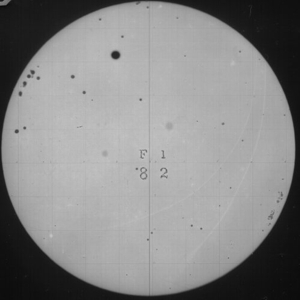

The Venus Transit 2004
... Brief InfoSheet F5
History of transit observing
5. The 1882 transit of Venus

One of the 1700 exposures of the Venus transit of 1882 (© U.S. Naval Observatory)
The 1882 transit, visible from South America, triggered also many voyages. The French organized ten expeditions: one to the island of Haiti (Callandreau), one to Mexico (Bouquet of Grye), one to Martinique (Tisserand, Bigourdan, Puiseux), one to Florida (Colonel Perrier), to Santa Cruz in Patagonia (CommanderFleuriais), one to Chile (Lieutenant of Bernardières), one to Chubut (Hatt), one to Rio-Negro (Perrotin, the director of Nice observatory), one to Cape Horn (Lieutenant Courcelle-Seneuil) and finally one to Bragado (Lieutenant Perrin).
The Naval Observatory at Washington D.C. sent eight expeditions throughout the world to observe the transit.
These voyages, again, were not limited to the study of the Venus transit, thus in the Sandwich Islands, in 1882, the Germans settled in Royal Bay within the framework of the first International Geophysical Year. A similar station was installed by the French at Orange Bay close to Cape Horn. On the same day, these two stations recorded a strange tidal oscillation. They found out later that it was a shock wave caused by the explosion of the Krakatoa volcano in Indonesia!
Reduction of the observations of these last two transits made it possible for Newcomb to calculate the value of the solar parallax with a precision of the order of one hundredth of a second of arc. Other parallax measurements were used to determine the solar parallax such as the parallax of Mars at opposition and the parallaxes of asteroids during near encounters with the Earth. However, it was necessary to await radar measurements of distance to obtain a very accurate value of the solar parallax and to confirm the good value obtained by Newcomb from the transits of Venus.
Want to know more?
This topic is discussed in a more detailed way in the associated Extended InfoSheet.
Back to the List of Brief InfoSheets.
